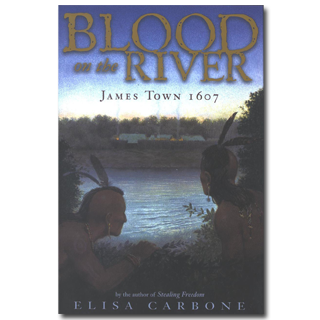
A FEW OTHER EVENTS FOR
DECEMBER 20:
- Happy birthday M.B. Goffstein (Fish for Dinner, Brookie and Her Lamb) and Sharon Chmielarz (Down at Angel’s, The Other Mozart: Poems).
- The Louisiana Purchase was completed at New Orleans ceremony in 1803. Read Louisiana Purchase by Peter and Connie Roop, illustrated by Sally Wern Comport.
- On this day in 2007, Queen Elizabeth II becomes the oldest ever monarch of the United Kingdom. The previous record holder was Queen Victoria at 81 years 7 months 29 days. Read A Little Princess by Frances Hodgson Burnett, illustrated by Tasha Tudor and A Proud Taste for Scarlet and Miniver by E.L. Konigsburg.
On December 20, 1606, three small ships, Susan Constant, Goodspeed, and Discovery departed from London, England, to America. When they landed on May 14 of the next year, the passengers, sent by the Virginia Company, established what would become the first permanent settlement in the United States: Jamestown, Virginia.
The characters of this early-American drama—Captain John Smith, Pocahontas, the Indian princess, her father, Pohwatan—have become part of the American myth, taught to all school children. But what really happened at Jamestown? What did that settlement feel like to those who came to the inhospitable land?
In Blood on the River, Elisa Carbone makes this history exciting and real. As her protagonist, she selected one of the boys, Samuel Collier, who came with the first settlers; Samuel learned to master the survival skills necessary for living in this new land and became an elder statesmen in his later days. Carbone invents a backstory for Samuel, who she imagines was an orphan taken on board ship as the serving boy of Captain John Smith. Hence Samuel can watch, and participate, in all the key events.
In a book that combines the three crucial elements of great historical fiction—a sense of place, a sense of story, and a sense of history—Carbone stays true to the known facts but weaves them into a page-turning, exciting drama. Samuel learns to turn his anger into negotiation, just like his master, John Smith. He slowly masters the Algonquian language. In fact, like many pioneer children, Samuel prefers staying in one of the Algonquian villages, rather than Jamestown. There children are better fed, better cared for, and have more freedom.
As settlers squabble and die, starve and try to learn to harvest the land, Samuel and Captain John Smith remain steadfast in their desire to make a successful colony. Carbone prefers the theory that Pocahontas saved Smith as part of an “adoption ceremony” and paints a convincing argument for that version of history through the narrative.
Blood on the River has moved into the fifth through seventh grade curriculums across the country and emerged as a work of historical fiction that young readers ages ten to fourteen truly enjoy. If you like to pair fiction and nonfiction, Sally Walker’s superb Written in Bone will help round out the Jamestown story. For me, Blood on the River is the next best thing to a time machine—it re-creates the incidents, the tensions, and the drama of early America.
Here’s a passage from Blood on the River:
Soon there are so many sick that there is no one with strength to tend the gardens, no one with strength to hunt or fish. We are left with a cup of barley and a cup of wheat for each man per day, and this is filled with wriggling mealworms. I help cook the gains in the pot over our communal cook fire, and I watch as the mealworms float to the top.
As we grow hungrier, more and more men become ill. Those who still have the energy to argue have theories about what is causing the sickness.
Originally posted December 20, 2011. Updated for .





